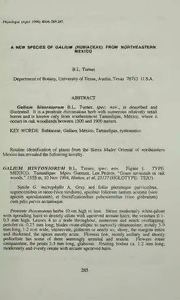
A new species of Galium (Rubiaceae) from northeastern Mexico PDF
Preview A new species of Galium (Rubiaceae) from northeastern Mexico
Phytologia (April 1996) 80(4):285-287. A NEW SPECIES OF GALIUM (RUBIACEAE) FROM NORTHEASTERN MEXICO B.L. Turner DepartmentofBotany,UniversityofTexas,Austin,Texas 78713 U.S.A. ABSTRACT Galium hintoniorum B.L. Turner, spec, nov., is described and illustrated. It is aprostrate rhizomatous herb with numerous relatively small leaves and is known only from southernmost Tamaulipas, Mexico, where it occursinoakwoodlandsbetween 1300and 1900meters. KEY WORDS: Rubiaceae, Galium,Mexico,Tamaulipas,systematics Routine identification of plants from the Sierra Madre Oriental of northeastern Mexicohasrevealedthefollowingnovelty. GALIUM HINTONIORUM B.L. Turner, spec. nov. Figure 1. TYPE: MEXICO. Tamaulipas: Mpio. Guemes, Los Pedros, "Grass savannah in oak woods," 1355m, 10Nov 1994,Hinton, etal. 25727(HOLOTYPE: TEX!). Simile G. microphyllo A. Gray sed foliis plerumque parvioribus, nigrescentibusinsicco(viceviridium),apicibus foliorum tanUim acutatis (vice apicum apiculatorum), et fructificationibus pubescentibus (vice glabrarum) cumpilisparvisarcuatisque. Prostrate rhizomatous herbs 10 cm high or less. Stems moderately white-pilose with spreading hairs to densely ciliate with upcurved arcuate hairs, the vestiture 0.1- 0.3 mm high. Leaves 4 to a node throughout, numerous and much overlapping; petiolesca. 0.25 mm long; blades ovate-elliptic to narrowly oblanceolate, mostly 3-9 mm mm long, 1-2 wide, uninervate, glabrous or nearly so, shiny, the margins entire and thickened, the apices merely acute. Rowers few, mostly axillary and shortly pedicellate but some of them seemingly terminal and sessile. Rowers rotate campanulate, the petals 2-3 mm long, glabrous. Fruiting bodies ca. 1.2 mm long, moderatelyandevenlyornatewitharcuateupcurvedhairs. 285 PHYTOLOGIA 286 April 1996 volume80(4):285-287 Figure 1. Galium hintoniorum, from holotype; upper right, portion of midstem showingleaves;lowerright,fruitingbody. Turner NewGaliumfrom Mexico 287 ADDITIONAL SPECIMENS EXAMINED: MEXICO. Tamaulipas: Mpio. Hidalgo, LosCaballos, 1705m,21 Sep 1994,Hinton, eWtal. 24804(TEX); road from Sta. &igracia toward Duices Nombres, N.L., 0.3 mi of Paraje de Los Caballos (22° 58' 39" N X 99° 29' 31" W), 1840 m, 21 Sep 1994, Nesom 7460 with Jaime Hinton&M. Mayfield) (TEX). Galiumhintoniorummuch resembles G. microphyllum but it apparently lacks the 4-bractedflowersofthattaxon, and the fruits are ornamented with recurved hairs, as illustrated in Figure 1. Additionally, the foliage dries black and is more densely packed, the leaves lacking whip-like acuminations at their apices as occur in G. microphyllum. In short, the species appears to stand somewhere between the Relubium taxa {Galium microphyllum, et al.) and the more typical elements of Galium, seemingly vitiatingthecharactersuponwhichthesetwogeneraarefounded. The species is named for the Hinton family, all of the collections having been madebyorwithJaimeHinton,theextantpatriarchofthatremarkableclan. ACKNOWLEDGMENTS I am grateful to Gayle Turner for the Latin diagnosis, and to her and Ted Delevoryasforreviewingthemanuscript. MariaThompsonprovidedtheillustration.
